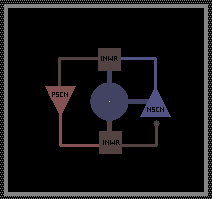Difference between revisions of "Element:INWR"
(Undo revision 5545 by SopaXorzTaker (talk), and fixed some incorrect information) |
MachineMan (talk | contribs) m (INWR now conducts to and from WIFI, so I fixed the wiki saying otherwise.) |
||
| (5 intermediate revisions by 3 users not shown) | |||
| Line 6: | Line 6: | ||
| identifier = DEFAULT_PT_INWR | | identifier = DEFAULT_PT_INWR | ||
| name = INWR | | name = INWR | ||
| − | | description = | + | | description = Doesn't conduct to metal or semiconductors. |
| colour = 544141 | | colour = 544141 | ||
| menusection = SC_ELEC | | menusection = SC_ELEC | ||
| Line 38: | Line 38: | ||
}} | }} | ||
| − | Insulated Wire | + | Insulated Wire's description is slightly misleading, as it does, in fact, conduct to some semiconductors ({{Material | PSCN}} and {{Material | NSCN}}). |
| − | ( | ||
| − | === | + | == Properties == |
| + | ==== SPRK ==== | ||
| + | INWR has much more restricted {{Material | SPRK}} conduction rules than most other elements, hence "insulated". There are only 5 elements which INWR conducts SPRK to/from: | ||
| − | + | {{MaterialBtn | INWR}} {{MaterialBtn | PSCN}} {{MaterialBtn | NSCN}} {{MaterialBtn | WIFI}} - INWR conducts to and from these elements | |
| − | + | INWR conducts to, but not from, {{MaterialBtn | SWCH}} | |
| + | |||
| + | ==== BRAY ==== | ||
| + | INWR is transparent to {{Material | BRAY}} beams, they always go right through instead of being blocked. This allows BRAY beams to cross each other - a BRAY beam normally blocks other beams of white BRAY which cross it, unless the space where the beams would cross contains a particle that is transparent to BRAY. | ||
| + | |||
| + | Some other elements are also transparent to BRAY, such as {{Material | FILT}} and {{Material | ARAY}}, but most of them block BRAY. | ||
| + | |||
| + | INWR does not get sparked by any {{Material | BRAY}} beams which pass through it (most conductors get sparked when hit by BRAY). | ||
== Uses == | == Uses == | ||
| − | It can allow creation of "crossings", because | + | It can be used in electronics to allow creation of "crossings" for SPRK, because INWR does not conduct to or from most other electronic elements. |
| − | + | ||
| − | It can be | + | Transparency to BRAY means INWR can be used as ROM (read by ARAY) in printers to store the image, and in decoders. |
| + | |||
| + | When sparked repeatedly, INWR rapidly cools to 22°C which is very useful were temperature needs to be limited, or rapid cooling is desired. | ||
| + | |||
| + | == Creation == | ||
| + | It can be created only by drawing with the brush or cloning, there are no reactions which create INWR. | ||
| − | + | == Examples == | |
{|border="1" cellpadding="5" cellspacing="0" | {|border="1" cellpadding="5" cellspacing="0" | ||
|- | |- | ||
Latest revision as of 05:10, 21 January 2023
 Doesn't conduct to metal or semiconductors. | |
| Properties | |
|---|---|
| Section | Electronics |
| Spawn temperature | 22°C |
| Heat Conductivity | 100% |
| Relative weight | 100 |
| Gravity | 0 |
| Acid dissolve rate | 0.1% |
| Flammability | 0 |
| State | Solid |
| Transitions | |
| High temperature |
|
| Misc properties | |
| Conducts electricity (SPRK) | |
| Source code | |
Insulated Wire's description is slightly misleading, as it does, in fact, conduct to some semiconductors (PSCN and NSCN).
Contents
Properties
SPRK
INWR has much more restricted SPRK conduction rules than most other elements, hence "insulated". There are only 5 elements which INWR conducts SPRK to/from:
![]()
![]()
![]()
![]() - INWR conducts to and from these elements
- INWR conducts to and from these elements
INWR conducts to, but not from, ![]()
BRAY
INWR is transparent to BRAY beams, they always go right through instead of being blocked. This allows BRAY beams to cross each other - a BRAY beam normally blocks other beams of white BRAY which cross it, unless the space where the beams would cross contains a particle that is transparent to BRAY.
Some other elements are also transparent to BRAY, such as FILT and ARAY, but most of them block BRAY.
INWR does not get sparked by any BRAY beams which pass through it (most conductors get sparked when hit by BRAY).
Uses
It can be used in electronics to allow creation of "crossings" for SPRK, because INWR does not conduct to or from most other electronic elements.
Transparency to BRAY means INWR can be used as ROM (read by ARAY) in printers to store the image, and in decoders.
When sparked repeatedly, INWR rapidly cools to 22°C which is very useful were temperature needs to be limited, or rapid cooling is desired.
Creation
It can be created only by drawing with the brush or cloning, there are no reactions which create INWR.
Examples
| This shows an example of INWR not conducting to METL. | 44303View save 44303
|
| Language: | [[::Element:INWR|English]] |
|---|